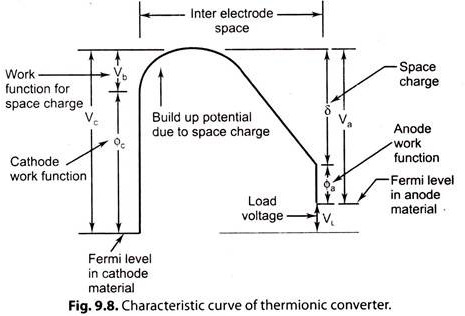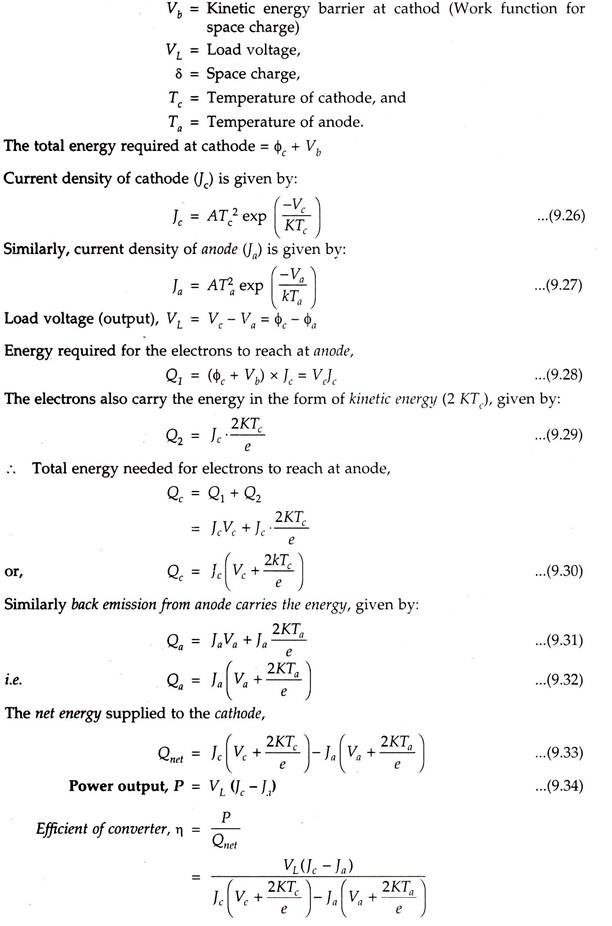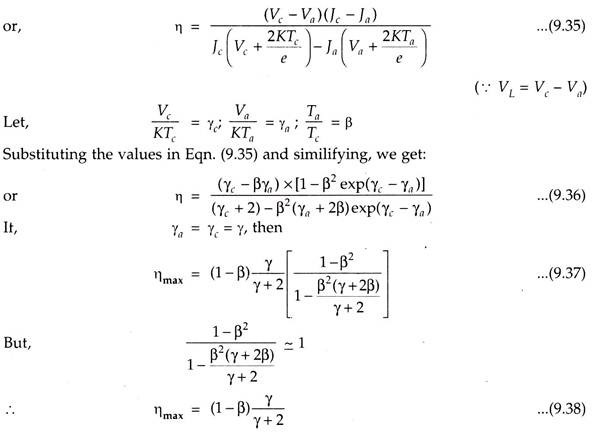Are you looking for an essay on ‘Thermionic Converter’? Find paragraphs, long and short essays on ‘Thermionic Converter’ especially written for school and college students.
Essay on Thermionic Converter
Essay Contents:
- Essay on the Introduction to Thermionic Converter/Generator
- Essay on the Desirable Properties of Thermionic Converter/Generator Materials
- Essay on the Advantages and Disadvantages of Thermionic Converter/Generator
- Essay on the Analysis of Thermionic Converter /Generator
Essay # 1. Introduction to Thermionic Converter/Generator:
A Thermionic converter (or generator) converts heat energy directly to electrical energy by utilising thermionic emission effect.
In this device, electrons act as the working fluid in place of a vapour (or gas) and electrons are emitted from the surface of the heated metal.
A thermionic converter can be analysed from at least three different points of view:
1. In terms of thermodynamics, it may be viewed as a heat-engine that uses an electron gas as a working substance.
2. In terms of electronics, it may be viewed as a diode that transforms heat to electricity by the law of thermionic emission.
3. In terms of thermoelectricity, it may be viewed as a thermocouple in which an evacuated space or a plasma has been substituted for one of the conductors.
Regardless of the point of view adopted in analysis, a thermionic converter works because of the phenomenon of “thermionic emission”. Thermionic emission implies emission of electrons from the metal when it is heated.
Work Function (ɸ):
It is defined as the energy required to extract an electron from the metal. It is measured in electron volts. The value of work function varies with the nature of the metal and its surface condition.
A thermionic converter, in principle, consists of two metals or electrodes with different work functions sealed into an evacuated vessel. The electrode with a large work function is maintained at a higher temperature than one with the smaller work function.
Essay #
2. Desirable of Properties Thermionic Converter/Generator Materials:
The problem of developing materials suitable for use in thermionic converters ranks next to the space charge control problem in the development of efficient thermionic generators.
Following properties are desirable in materials suitable for converters:
Emitter:
A good emitter should have the following properties:
1. High-electron emission capability coupled with a low rate of deterioration.
2. Low emissivity, to reduce heat transfer by radiation from the emitter.
3. High mechanical strength.
4. High melting point.
5. It should be such that in the event some of it vapourizes and subsequently condenses on the collector it will not poison the collector (that is, change the collector properties, thereby making it less effective).
The relative importance of these properties is dependent upon the type of converter being designed. It should be noted that efficiency is a much slower rising function of electron emission capability if space charge is present than if there is no space charge.
The work function may be reduced considerably by an absorbed single layer of foreign atoms. This comes about by the establishment of a dipole layer at the surface. The layer can be formed by atoms or molecules. This is essentially what happens in a cesium converter, which is designed so that cesium condenses on the emitter or collector.
Collector:
The main criteria for choosing a ‘collector material’ is that it should have as low a work function as possible.
i. Because the collector temperature is held below any temperature that will cause significant electron emission, its actual emission characteristics are of no consequence. The lower the collector work function (ɸc), however, the less energy the electron will have to give up as it enters the collector surface.
ii. In practice the lowest value of ɸc that can be maintained stably is about 1.5 eV.
iii. For applications in which it is desirable to maintain the collector at elevated temperatures (greater than 900°K) such as space applications, an optimum value of ɸc may be determined.
iv. Molybdenum has been widely used as a collector; it is frequently assumed to have a work function of 2.7 eV.
Essay #
3. Advantages and Disadvantages of Thermionic Converter/Generator:
Following are the advantages, disadvantages/limitations and applications of thermionic converter:
Advantages of Thermionic Converter/Generator:
1. Compact device.
2. High conversion efficiency.
3. Quiet in operation and durable.
4. Low cost and less maintenance required.
5. Absence of rotating parts.
6. Operates at high temperatures.
7. Can be developed for very low power to very high power generation.
8. Can operate in remote areas and harsh environments.
Disadvantages of Thermionic Converter/Generator:
1. Metal is costly as it has to withstand high temperatures.
2. Needs high operating temperatures at anode.
3. Needs special seal to protect the cathode from corrosive gases.
4. Needs cesium vapour in the tube to reduce the space charge. Applications:
1. Power generation in both centralised and distributed systems.
2. Residential and Commercial purposes.
3. Automobiles, marine and air vehicles.
4. Electronics and telecommunications.
5. Aerospace and military systems.
Essay #
4. Analysis of Thermionic Converter/Generator:
Fig. 9.8, shows the characteristic curve of thermionic converter.



